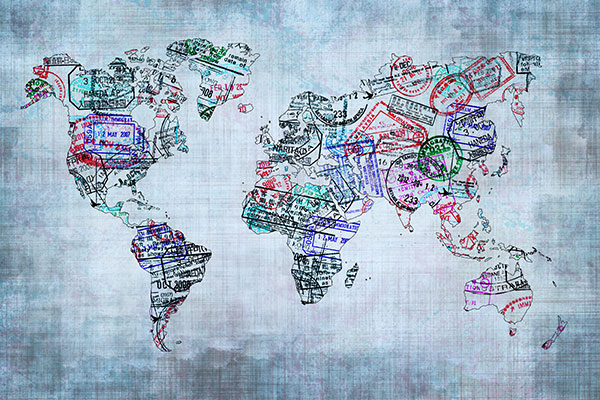Travel is integral to many of my stories, and those journeys are rooted as much in my parents’ lives as my own.
Lance E. Snr. joined the Navy in 1922, but changed to civilian work in 1946. A year later I was born to a family of four daughters, and he and I formed a “gender alliance” by which we coped, defining my first three decades. Yet, my mother’s drive to “rise above her station” was the source of my ambition, and seeing her board a TWA Lockheed Constellation in 1957 bound for a European holiday is a vibrant memory.
Meanwhile, two local naval bases planted the legend “Join the Navy – See the World” in my childhood brain, while my dad spun yarns of life on the high seas, of “hindoos of the East,” of their gold-currency trading houses, of North Sea storms on the Murmansk Run, and of coal-burning “battlewagons” and Valparaiso nights. In a snapshot he left, he stands with his shipmates in a 1920s Rio de Janeiro bar, all covered in grins and local hostesses.
These accounts captured that rugged, swaggering era of valorous adventures and grand crossings, and branded his only son with the mark of Cain the Wanderer. Though my father’s years at sea were before I was born, it was that maritime life in retrospect, off in the middle distance, that infused the real color into my first visions of travel.
In time, those stories from my childhood merged with films, books, and the 1960s’ proto-grunge surf scene and its pre-hippie nomads. We’d skip school, tie the boards on the car, and go looking for trouble, too often finding it. Surfing cast us in the image of its totems, and onto the Ventura Highway. There from Haskell’s Ranch to Secos, Stanley’s to Trancas, from Snooker’s Pool Hall to Foster’s Freeze, we drank life in, and a dozen corner groceries somehow survived the shoplifting. We got our kicks cruising A Street on a Saturday night, or with a warm, wriggling body in the back of a van at the SkyView Drive-in.
We were searching out what we hadn’t seen, where we hadn’t been. At age nineteen, after “disturbing the peace and malicious mischief,” and with a hangover like a mortar barrage, I spent a weekend in the county lock-up with a young gent headed to the state pen for GTA and pistol-whipping a cop. I didn’t get a lot of sleep before getting bailed on Monday morning.
 By the end of the ‘Sixties, we were crossing into Mexico. It had nothing to do with Jack Kerouac, searching for growth, or the meaning of life. We were after strip clubs, beer, and being reckless. Moving, traveling, letting go of the ties that bind—whether that release was showing off for girls in Tijuana’s bullring, or lounging in Hussong’s bar, staring at the bottom of a Singapore Sling.
By the end of the ‘Sixties, we were crossing into Mexico. It had nothing to do with Jack Kerouac, searching for growth, or the meaning of life. We were after strip clubs, beer, and being reckless. Moving, traveling, letting go of the ties that bind—whether that release was showing off for girls in Tijuana’s bullring, or lounging in Hussong’s bar, staring at the bottom of a Singapore Sling.
Mexico led to Hawaii, and then to Europe. Picking up mail in Athens, I ran into Crazy Mike, an old surfing friend. As we drove into the Macedonian hills, he told me about trips to Alandipo, crossing the Khyber Pass to Rawalpindi, and tales of the pirates of Kalimantan. In Turkey, we parted. Mike taught me a lot—about life on the road, why retsina will never be Greece’s most valued export, and lessons that led to “The Get-away Man” and a grant to the Post-Grad Writers Conference in Vermont.
Since Greece, I’ve lived half my life overseas—in Brazil, the U.K., and, by huge good luck, New Zealand. I’ve been around the world too many times to count, in every direction, geographically and psychologically, traveling by foot, thumb, bicycle, motorcycle, Polish freighter, ferry, trolley, and train, by plane, helicopter, tuk-tuk, fishing smack, banana boat, and dug-out canoe. A life of travel has meant meeting friends in faraway places—a hotel in Saigon, a trout stream in New Zealand, Patagonia’s wilderness, or Rome’s Caracalla Baths to see “Aida”—but sometimes being alone.